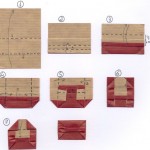He who practises Kindness will never have enemies.
Category: general
Confucius of the day
Origami Menger Sponges
1. Begin with a cube.
2. Shrink the cube to 1 / 3 of its original size and make 20 copies of it.
3. Place the copies so they will form a new cube of the same size as the original one but lacking the centerparts, (next image).
4. Repeat the process from step 2 for each of the remaining smaller cubes.
After an infinite number of iterations, a Menger sponge will remain.
from Wikipedia
 The Menger Sponge is a fractal particularly appealing to modular origamists, for two reasons: it can be made out of Sonobe modules (the very first “brick” that every origamist learns), and given its fractal nature, it can be expanded forever and ever. What follows is a list of origami websites on this fascinating structure: Continue reading Origami Menger Sponges
The Menger Sponge is a fractal particularly appealing to modular origamists, for two reasons: it can be made out of Sonobe modules (the very first “brick” that every origamist learns), and given its fractal nature, it can be expanded forever and ever. What follows is a list of origami websites on this fascinating structure: Continue reading Origami Menger Sponges
Plautus of the day
Plautus of the day
Lego of Choice: Digital Designer
With the free Digital Designer software you can build absolutely anything with virtual LEGO bricks right on your computer. Then you can buy the real bricks to build your creation and you can share it with thousand of other LEGO fans.
 One of the problems I used to face every time I wanted to make my own lego models was that I never had enough bricks of the kind I was needing. It must be one of those “Murphy´s laws” that the brick you just need is the one you lack!
One of the problems I used to face every time I wanted to make my own lego models was that I never had enough bricks of the kind I was needing. It must be one of those “Murphy´s laws” that the brick you just need is the one you lack!
Until now, there was a partial solution to this issue: the L-cad program allowed you to design your model in the computer so that you could afterwards order the pieces you wanted. This walkaround was (is) very useful, but if there were an easier option to custom design-custom order models which was backed by lego, that would be amazing, and if it were user friendly… whoa!
Well, so a big WHOA! to lego, since they have done exactly that. Besides giving the users an easy way to design models on the computer, they have made it just as easy to order those models as custom sets. Again, WHOA!! 😀
Plautus of the day
The Ufo detectors
http://www.imagesco.com/ufo/index.html
Over the years many UFO sightings have reported magnetic and electromagnetic disturbances. The UFO Detector is designed to sense these disturbances and will signal their presence by flashing an LED and beeping.
 I don’t dare to say that there’s people out there who would actually buy these UFO detectors for the sake of… well, detecting UFOs, but you never know. Anyway, from a nerdologist point of view I think they could be classified as gadgets, as they are small, expensive and, unless you live near Roswell, you don’t really need them (but still want to try them, eh…).
I don’t dare to say that there’s people out there who would actually buy these UFO detectors for the sake of… well, detecting UFOs, but you never know. Anyway, from a nerdologist point of view I think they could be classified as gadgets, as they are small, expensive and, unless you live near Roswell, you don’t really need them (but still want to try them, eh…).
By the way, don’t miss the explanation of how they work. Since asking a local ET to fly nearby to try the device seems a little bit unpractical (lots of bureaucracy, mainly), at least they give several alternative ways to see that it works (whatever that means).
All in all, these UFO detectors, though expensive, are probably the best gift for those who want to believe (sing the soundtrack with me: nanananán-nanán-nan-nin-nin-nin-nin).
Easy life through practical origami: envelope
 My friend Covadonga sent me a very nice step-by-step guide to making this origami envelope, originally attributed to Frances Levangia. She writes, “I made these diagrams based on paper models because otherwise I would forget how to make it, so when I like something, since I have no idea of how to diagram, I do it in this way”. Thanks Covadonga! 🙂
My friend Covadonga sent me a very nice step-by-step guide to making this origami envelope, originally attributed to Frances Levangia. She writes, “I made these diagrams based on paper models because otherwise I would forget how to make it, so when I like something, since I have no idea of how to diagram, I do it in this way”. Thanks Covadonga! 🙂
While searching for information on the envelope, I came across this site, where you will find a very nice collection of letterfolds and envelopes diagrammed by John Cunliffe. This same model is included among them; for those who are learning how to read diagrams, it could be interesting to compare it with Covadonga’s instructions to see how the drawings translate themselves into foldings.
Related Article: Origami cd case



